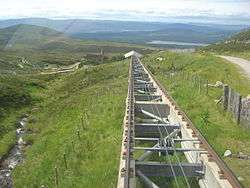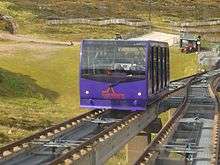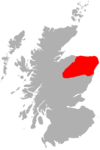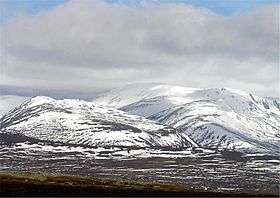Cairn Gorm
| Cairn Gorm | |
|---|---|
 Cairn Gorm from across Coire an t-Sneachda | |
| Highest point | |
| Elevation | 1,245 m (4,085 ft) [1] |
| Prominence | 145 m (476 ft) |
| Parent peak | Ben Macdui |
| Listing | Munro |
| Naming | |
| Translation | Blue or Green cairn (Gaelic) |
| Pronunciation | Scottish Gaelic: [əŋ ˈkʰaːrˠn̪ˠ ˈkɔɾɔm] |
| Geography | |
| Location | Cairngorms, Scotland |
| OS grid | NJ005040 |
| Topo map | OS Landranger 36 |
| Climbing | |
| Easiest route | Hike |
| Listed summits of Cairn Gorm | ||||
| Name | Grid ref | Height | Status | |
|---|---|---|---|---|
| Cairn Lochan | NH985025 | 1215 | Munro Top | |
| Stob Coire an t-Sneachda | NH996029 | 1176 | Munro Top | |
| Cnap Coire na Spreidhe | NJ013049 | 1150 | Munro Top | |
| Creag an Leth-choin | NH968033 | 1053 | Munro Top | |
Cairn Gorm (Cairngorm) (Gaelic: An Càrn Gorm, meaning Blue or Green Hill) is a mountain in the Scottish Highlands overlooking Strathspey and the town of Aviemore. At 1245 metres (4084 ft) it is the sixth-highest mountain in the United Kingdom. It has given its name to the whole range, although these hills were historically known as Am Monadh Ruadh (the Red Hills) rather than the Cairngorms. Cairn Gorm is the most prominent of the Cairngorm mountains in the view from Aviemore, but it is not the highest.
600 ha of the north-western slopes of the mountain have been developed since 1960 for downhill skiing, in Coire Cas and Coire na Ciste. In 2001 a funicular railway was constructed to provide access through Coire Cas to the Ptarmigan building at 1087m on Cairn Gorm.
The corrie south of Coire Cas, Coire an t-Sneachda, is separated from the skiing area by a ridge known as Fiacaill a' Choire Chais. The southern side of Cairn Gorm overlooks the remote loch known as Loch Avon (pronounced Loch A'an).
There is an automated weather station (AWS) controlled by Heriot-Watt University on the summit of the mountain[2] providing temperature and wind speed data. There is also a separate AWS run by the Met Office (synop code 03065).
Walking and climbing
The ascent of Cairn Gorm is technically straightforward via the Northern slopes, but weather conditions can make it impossible during high winds and falling or blowing snow (often referred to as blizzard conditions). The Windy Ridge path on Sròn an Aonaich lying to the northeast of Coire Cas is a steep and direct route, and is generally recommended by local Rangers, guides and guidebooks.[3] Another route to the summit is the access road up the centre of Coire Cas, however this route is a track used by the railway operator's vehicles, and gives an indirect route with several steep sections. It is not recommended as an ascent route, especially during the skiing season, though it gives good views of the Cairngorm Mountain Railway in its lower sections. Also in Coire Cas, Fiacaill a' Choire Chais offers a good walking route to Cairn Gorm and the adjacent plateau. A circuit of the cliff tops overlooking the Northern Corries of Cairn Gorm is highly recommended in many guide books and publications, giving one of the finest views in Scotland.[4] Walkers are advised to consult the local map[5] and call in at the Ranger Base at the car park.
There are many climbing routes at the head of Coire an t-Sneachda[6] and Coire an Lochain,[7] and in winter these corries form one of Scotland's major ice climbing areas.
1971 disaster
On 21–22 November 1971, five pupils from Ainslie Park High School in Edinburgh and a trainee instructor from Newcastle-under-Lyme died in a blizzard at Feith Buidhe on the Cairn Gorm plateau.[8] It stands as the UK's worst mountaineering disaster.[9]
Cairngorm Mountain ski resort
| Cairngorm Mountain | |
|---|---|
|
Cairngorm Mountain base station in early 2008 | |
| Location |
Carn Gorm, Aviemore Highland, Scotland United Kingdom |
| Nearest city | Inverness - 40 mi. (65 km) |
| Vertical | 500 m |
| Top elevation | 1145 m |
| Base elevation |
645 m Base Station |
| Runs |
35 |
| Lift system |
14 - 1 railway (120 person) - 2 doubles (mothballed) - 11 surface |
| Snowmaking | 4 TechnoAlpin T40, 1 TechnoAlpin TF10 |
| Night skiing | occasional |
| Website | CairnGorm Mountain |
History
The ski resort was developed on Cairn Gorm from 1960 onwards. A chairlift and chalet opened in December 1961.[10] It is the second largest in Scotland (after Glenshee). By the 1980s, thousands of skiers were using the resort on busy weekends, and the slopes could become very crowded.[11]
By the 2000s, the number of skiers at Cairngorm and Scotland's other ski areas had dropped, partly as a consequence of budget airline travel making access to the Alps easier.[12] The impact of Global Warming also emerged as a threat to the financial viability of the Scottish ski industry, with Adam Watson predicting in 2004 that there would be no more than twenty years left for the industry.[13]
Snow lie and weather conditions are unpredictable, but recent seasons, such as the winter seasons of 2005–2006, 2008–2009, 2009–2010 and 2010-2011 have resulted in good snow cover. Usage has recovered significantly resulting in improved finances for the ski area.
In 2011–12 the resort was able to trial a TechnoAlpin T40 snow cannon, and in 2012–13 three more were leased from the manufacturers with an option to purchase.[14] A larger TF10 cannon was added for the 2013-14 season[15]
Funicular controversy

By 1990, much of the resort's original infrastructure was ageing and proving increasingly difficult to maintain. The chairlifts and tows were also susceptible to the high winds to which the mountain is prone, and were frequently forced to shut in winds above 25 mph (40 km/h). The Cairngorm Chairlift Company, who operated the resort, proposed removing the chairlift and replacing it with a funicular railway.
There was strong opposition to the funicular from environmental groups, who were concerned about damage to the mountain and its fragile soils and plants. The eventual compromise reached, after negotiations with Scottish Natural Heritage, allowed the Cairngorm Mountain Railway to be built, but with restrictions on its usage. Only those engaging in snow sports, or spectating, are allowed to exit from the top station. Other users can visit the restaurant and visitor centre, but are prevented from leaving the building to start a walk.

Further controversy mired the building project, with budget over-runs, allegations of conflicts of interest by those connected to both Highlands and Islands Enterprise and the construction company and questions raised about the use of public money. The construction was estimated to have cost around £19.6 million, mostly funded by Highlands and Islands Enterprise (HIE), a government body. £2.7 million was provided by the European Union. The funicular opened in December 2001[16]
Improved snow conditions in recent winters has increased its use by snowsports, according to Cairngorm Mountain Ltd but it is commercially dependent on other users. Recent good snow conditions helped the company record a profit of £736,031 for the year ending 31 March 2010, HIE is interested in selling the resort.[17] There are also groups campaigning to remove the restriction on walkers leaving the top station. In April 2014 Natural Retreats was chosen by HIE as the new operator of Cairngorm Mountain Ltd.[18]
Climate
Cairn Gorm has a marine alpine/polar/tundra climate as a result of its elevation and proximity to the tempering North Atlantic that keeps summer temperatures low and winter temperatures narrowly below freezing. The Met Office weather station only publishes temperature and frost data. Winter temperatures are not extreme when compared with other stations record low temperatures in the UK, but the severity of the climate is illustrated by its cold summers. Cairn Gorm averages 194.4 frost days per annum.[19] Unlike most climates of this type, the yearly mean at Cairn Gorm is actually above freezing.
| Climate data for Cairn Gorm Summit, Elevation: 1,245m (1981–2010) | |||||||||||||
|---|---|---|---|---|---|---|---|---|---|---|---|---|---|
| Month | Jan | Feb | Mar | Apr | May | Jun | Jul | Aug | Sep | Oct | Nov | Dec | Year |
| Average high °C (°F) | −1.3 (29.7) |
−1.5 (29.3) |
−0.9 (30.4) |
1.5 (34.7) |
4.3 (39.7) |
7.1 (44.8) |
9.5 (49.1) |
9.2 (48.6) |
6.9 (44.4) |
3.9 (39) |
0.8 (33.4) |
−0.5 (31.1) |
3.3 (37.9) |
| Daily mean °C (°F) | −3.4 (25.9) |
−3.8 (25.2) |
−3.0 (26.6) |
−1.0 (30.2) |
1.7 (35.1) |
4.4 (39.9) |
6.9 (44.4) |
6.6 (43.9) |
4.5 (40.1) |
1.6 (34.9) |
−1.3 (29.7) |
−2.8 (27) |
0.9 (33.6) |
| Average low °C (°F) | −5.5 (22.1) |
−6.1 (21) |
−5.0 (23) |
−3.4 (25.9) |
−0.9 (30.4) |
1.7 (35.1) |
4.2 (39.6) |
3.9 (39) |
2.1 (35.8) |
−0.7 (30.7) |
−3.3 (26.1) |
−5.1 (22.8) |
−1.5 (29.3) |
| Source: Met Office[20] | |||||||||||||
Wildlife
The mountain is home to a number of bird species, including dotterel and ring ouzel (in the spring and summer) and snow bunting and ptarmigan (also known as rock ptarmigan) (all year round). Mammals inhabiting the mountain include mountain hare and red deer. Wildflowers found on the mountain include dwarf cornel, cloudberry and butterwort. For many of these species of flora and fauna, Cairn Gorm is one of their key strongholds.[21]
Cairn Gorm Locomotive
A locomotive operated by Caledonian Sleeper, a train operator that offers sleeper trains from London Euston to Scotland. The locomotive is the only Class 67 locomotive to be operated by Caledonian Sleeper. The locomotive is the subject of a Hornby model with TTS Sound, in 00 Gauge.
References
- ↑ "walkhighlands Cairn Gorm". walkhighlands.co.uk. 2013. Retrieved 7 October 2013.
- ↑ "Cairn Gorm Weather Station". Heriot-Watt University. Dept. of Physics. Retrieved 2008-03-17.
- ↑ "Cairn Gorm and the northern corries - Route Map".
- ↑ Adam Watson. The Cairngorms, Scottish Mountaineering Trust
- ↑ Ordnance Survey. 1:50,000 scale. Sheet 36. Grantown and Cairngorm.
- ↑ "Coire an t'Sneachda".
- ↑ "Coire an Lochain (Cairngorm)".
- ↑ "Cairngorm Disaster 1971 - Scottish Saltire Branch - Aircrew Association". Archived from the original on 7 April 2016.
- ↑ Cairngorm Mountain Rescue Association. 1988. Friends In High Places. ed Cliff, Peter.
- ↑ "End of the trudge up Cairngorm. Official Opening of Chair-lift". The Glasgow Herald. 25 December 1961. p. 8. Retrieved 4 June 2017.
- ↑ "Cairngorm ski expansion starts Battle of Lurcher's Gully". The Glasgow Herald. 7 April 1980. p. 7. Retrieved 4 June 2017.
- ↑ "Going downhill". The Scotsman. 12 December 2006. Retrieved 4 June 2017.
- ↑ Seenan, Gerard (14 February 2004). "Global warming forces sale of Scottish winter sports resorts". The Guardian. Retrieved 4 June 2017.
- ↑ "Technoalpin continue business in Scotland " TechnoAlpin. Retrieved 1 Dec 2012.
- ↑ "Key facts on the Cairngorm ski resort". The Scotsman. 1 December 2013. Retrieved 4 June 2017.
- ↑ Grant, Christine (24 December 2001). "Cairngorm funicular railway opens at last". The Scotsman. Retrieved 4 June 2017.
- ↑ Ross, John (6 September 2005). "Summit for sale as HIE prepares to part with Cairn Gorm". The Scotsman. Retrieved 2006-11-23.
- ↑ "CairnGorm Mountain's new operator confirmed as Natural Retreats UK". BBC News. 7 April 2014. Retrieved 2014-04-24.
- ↑ "Cairn Gorm Summit climate". Met Office. Retrieved 5 August 2015.
- ↑ "Cairn Gorm Summit climate". Met Office. Retrieved 5 August 2015.
- ↑ See, for example, Lee Evans, Ultimate Site Guide to Scarcer British Birds (1996).
External links
- Computer generated summit panoramas North South here
- Cairn Gorm Weather Station
- CairnGorm Mountain Ltd.

